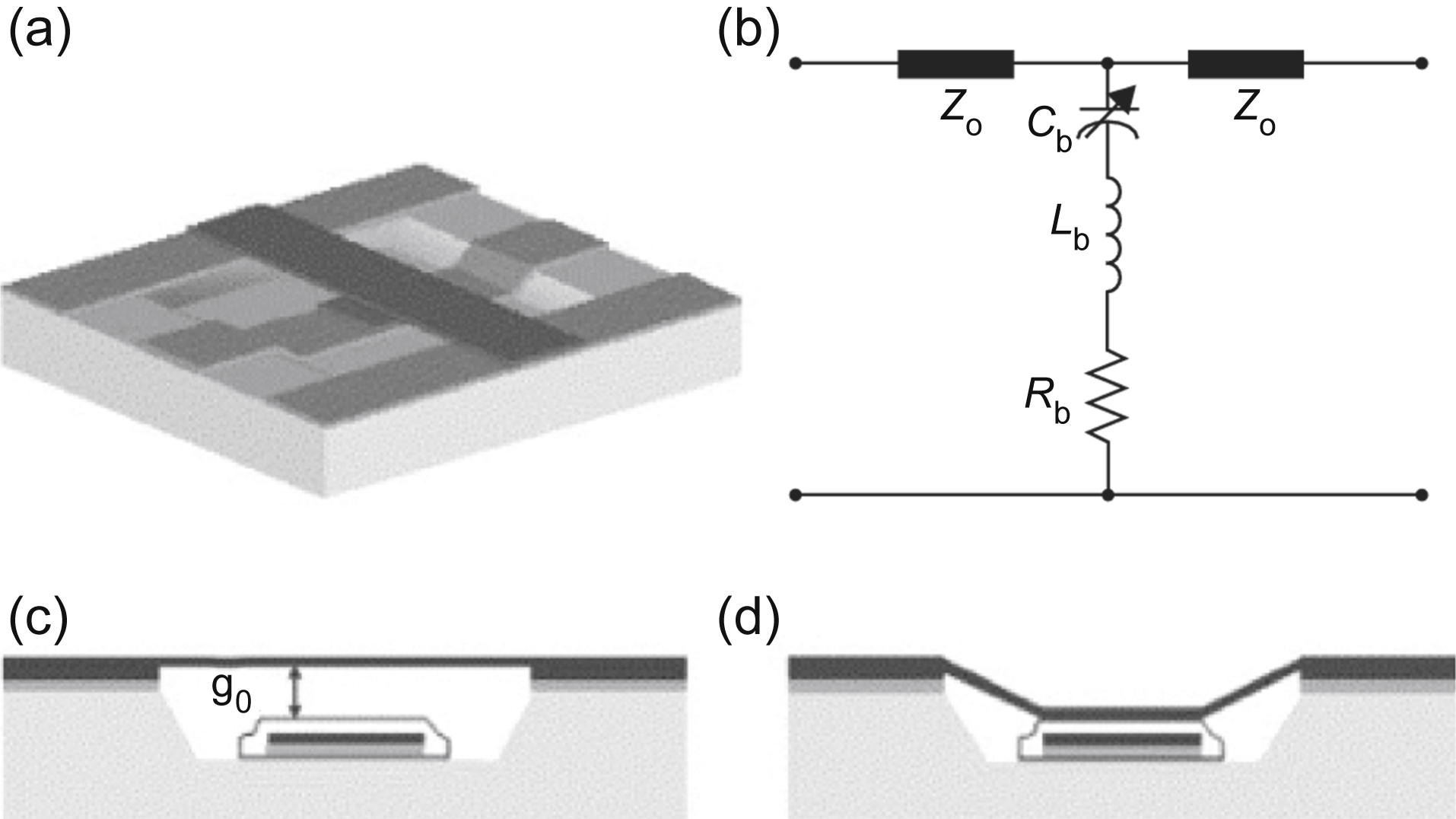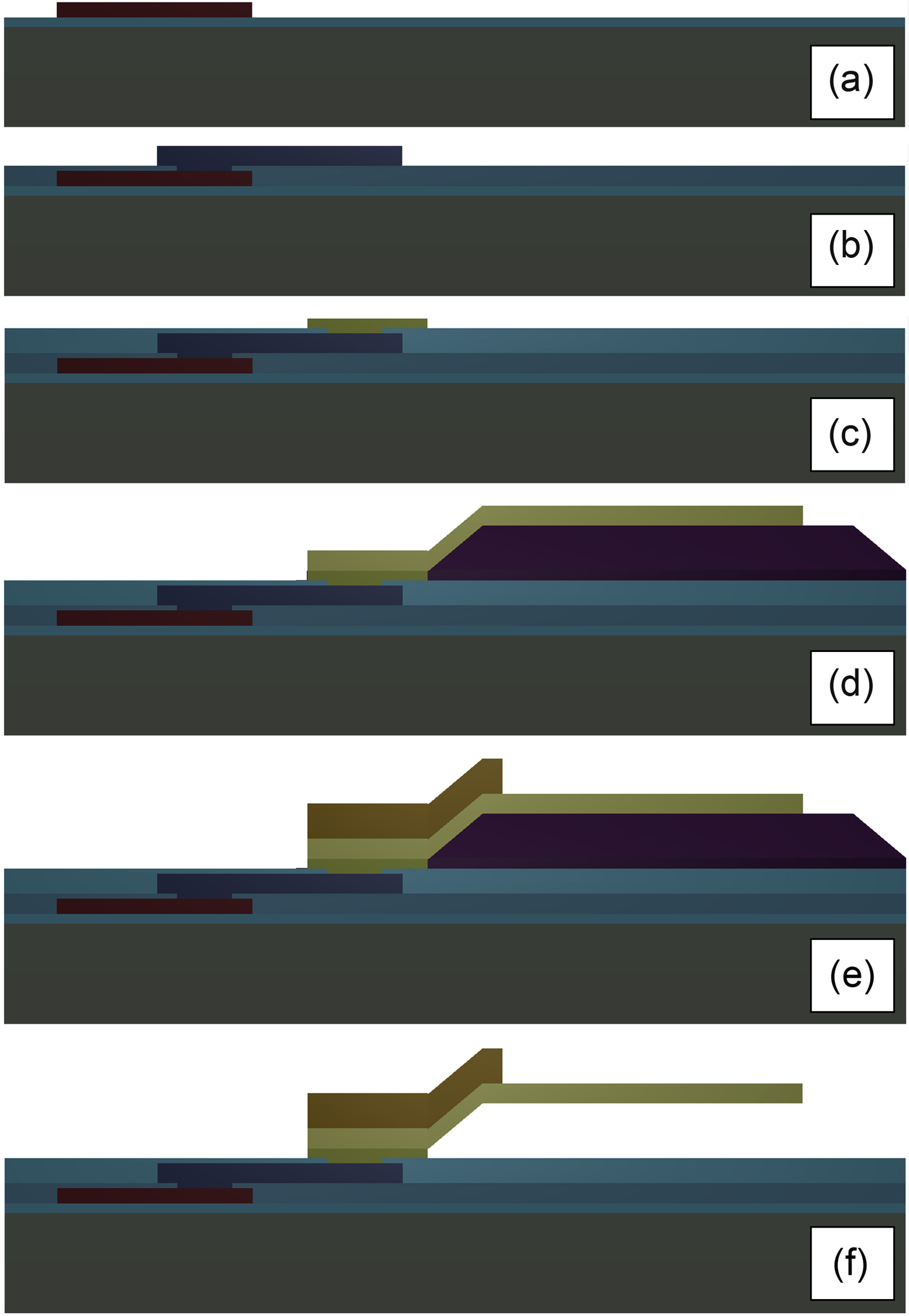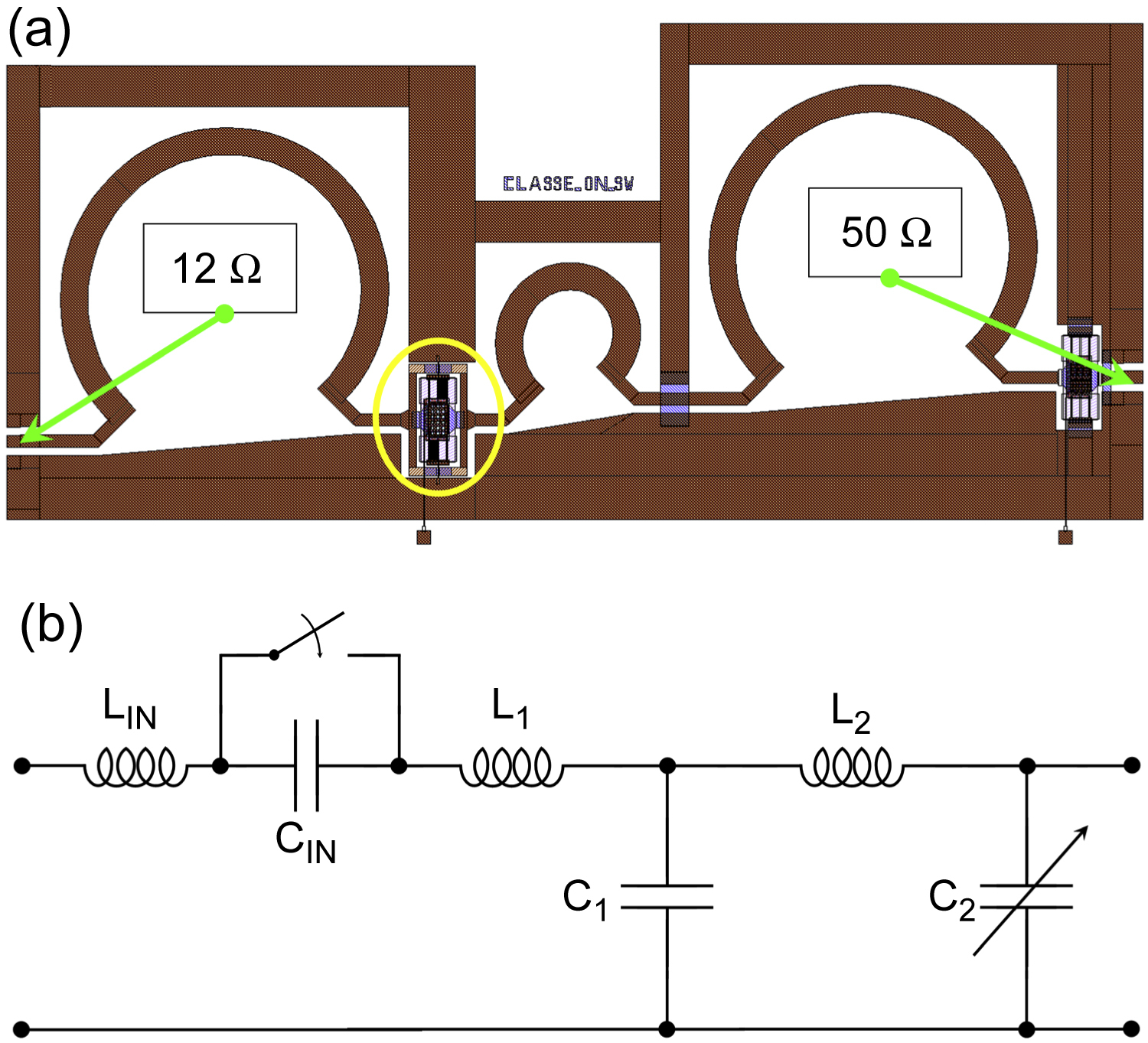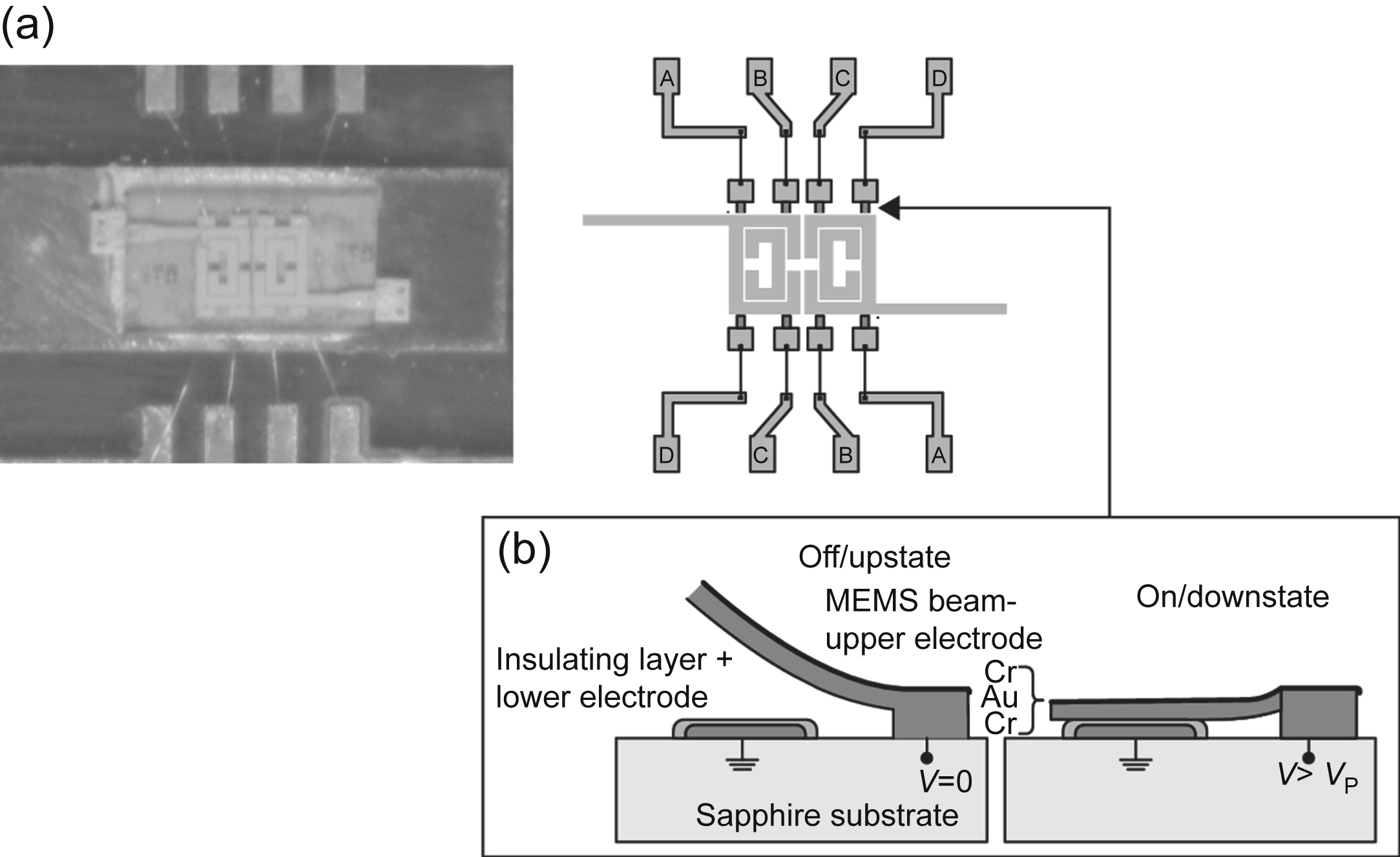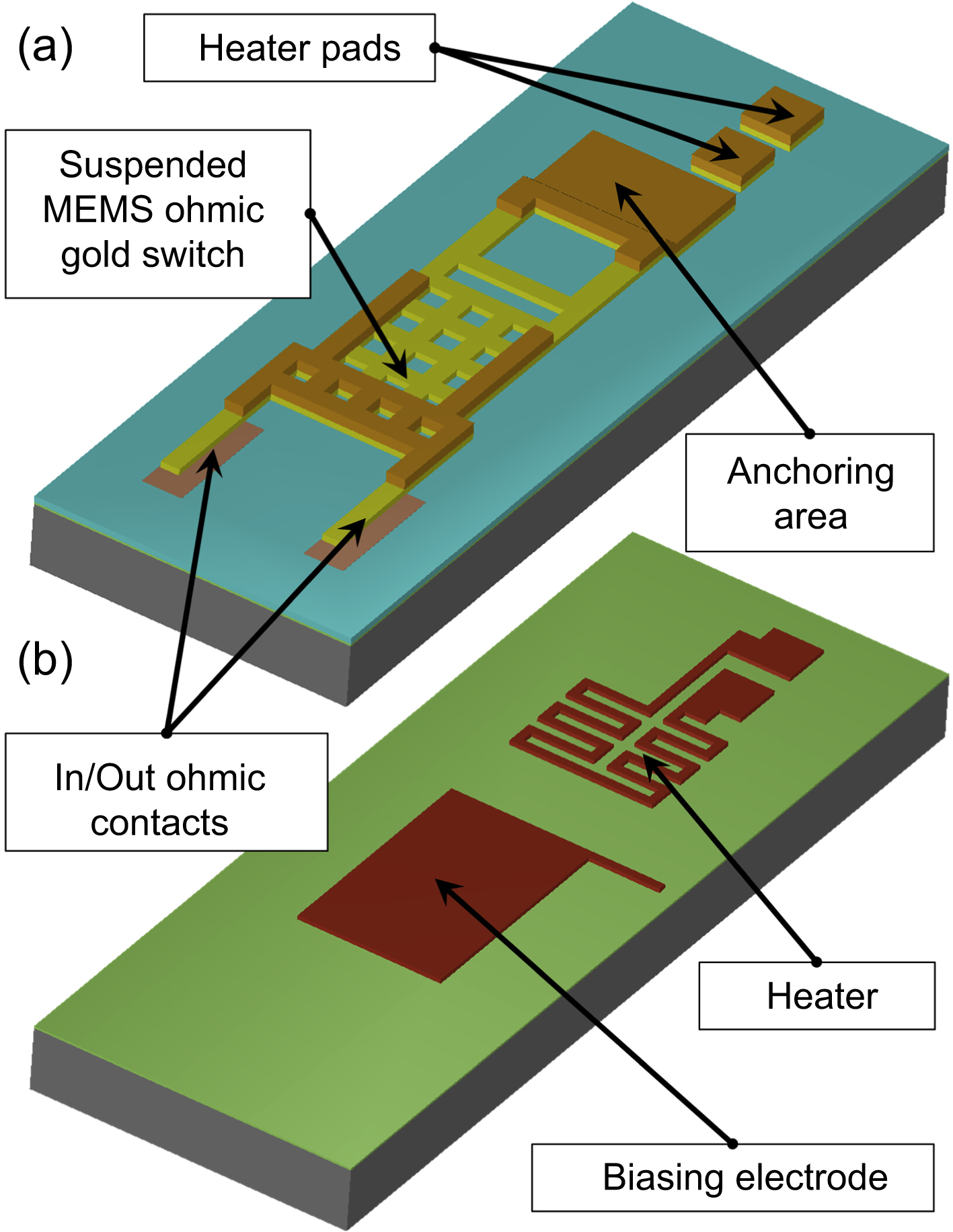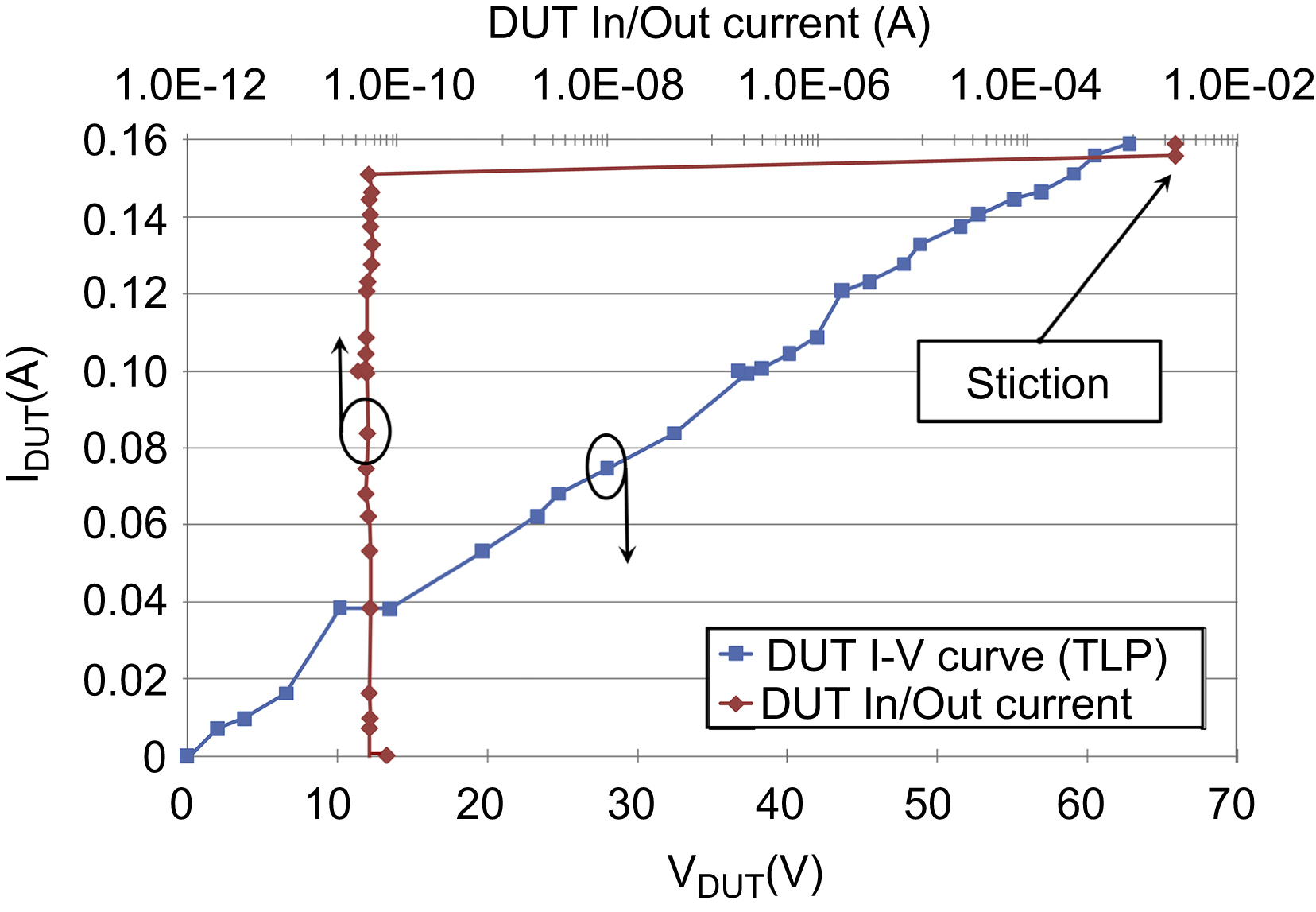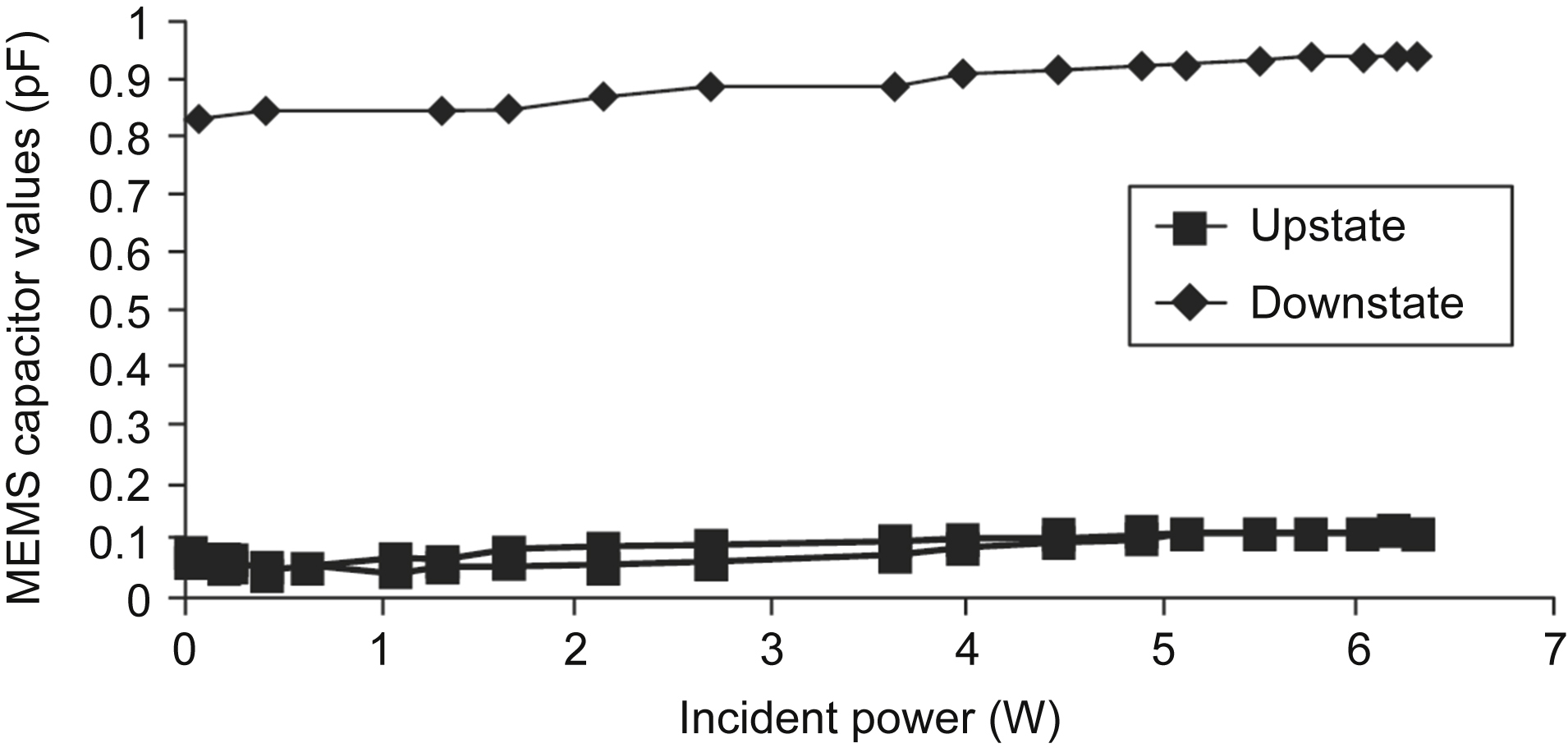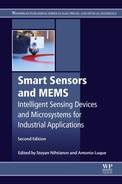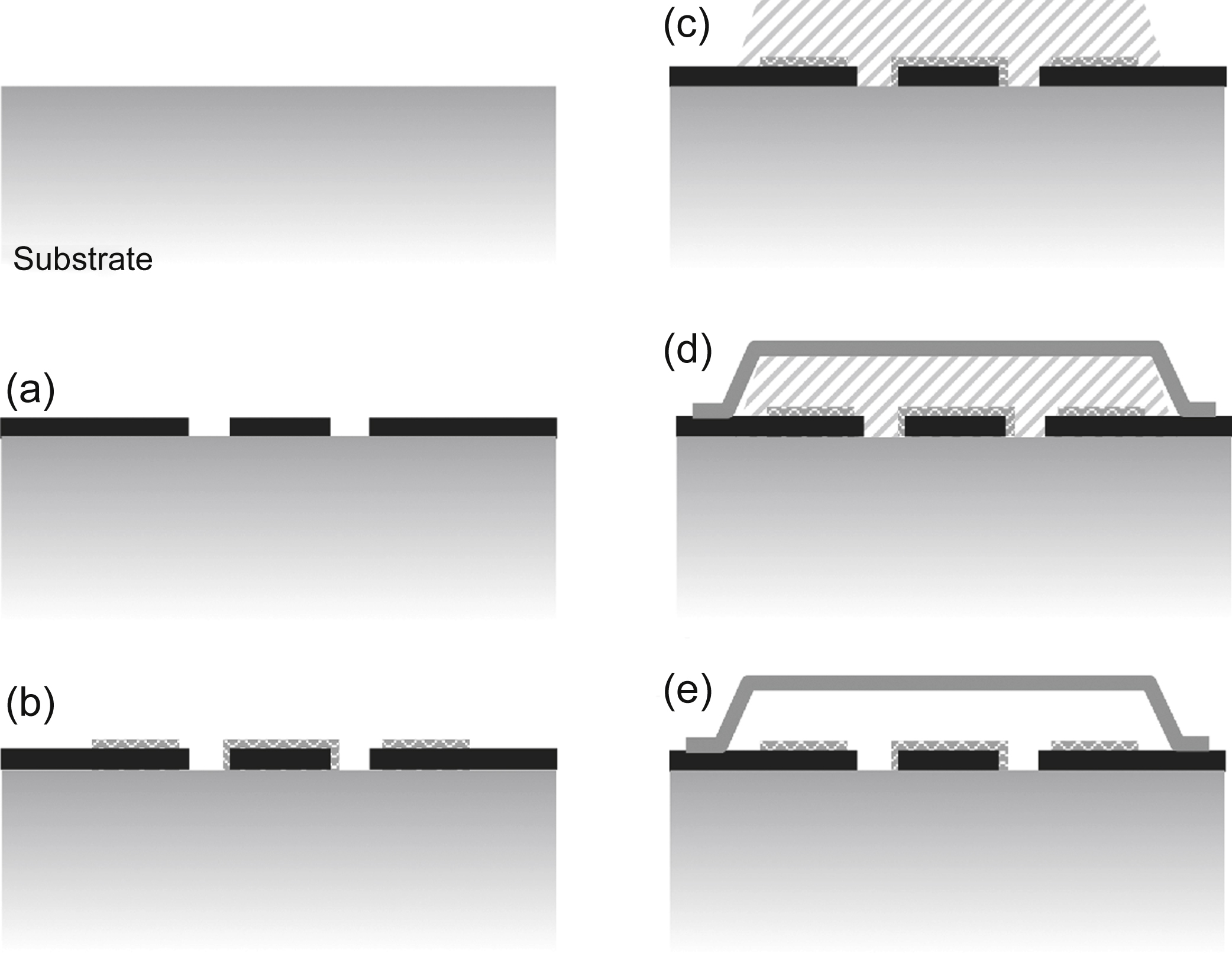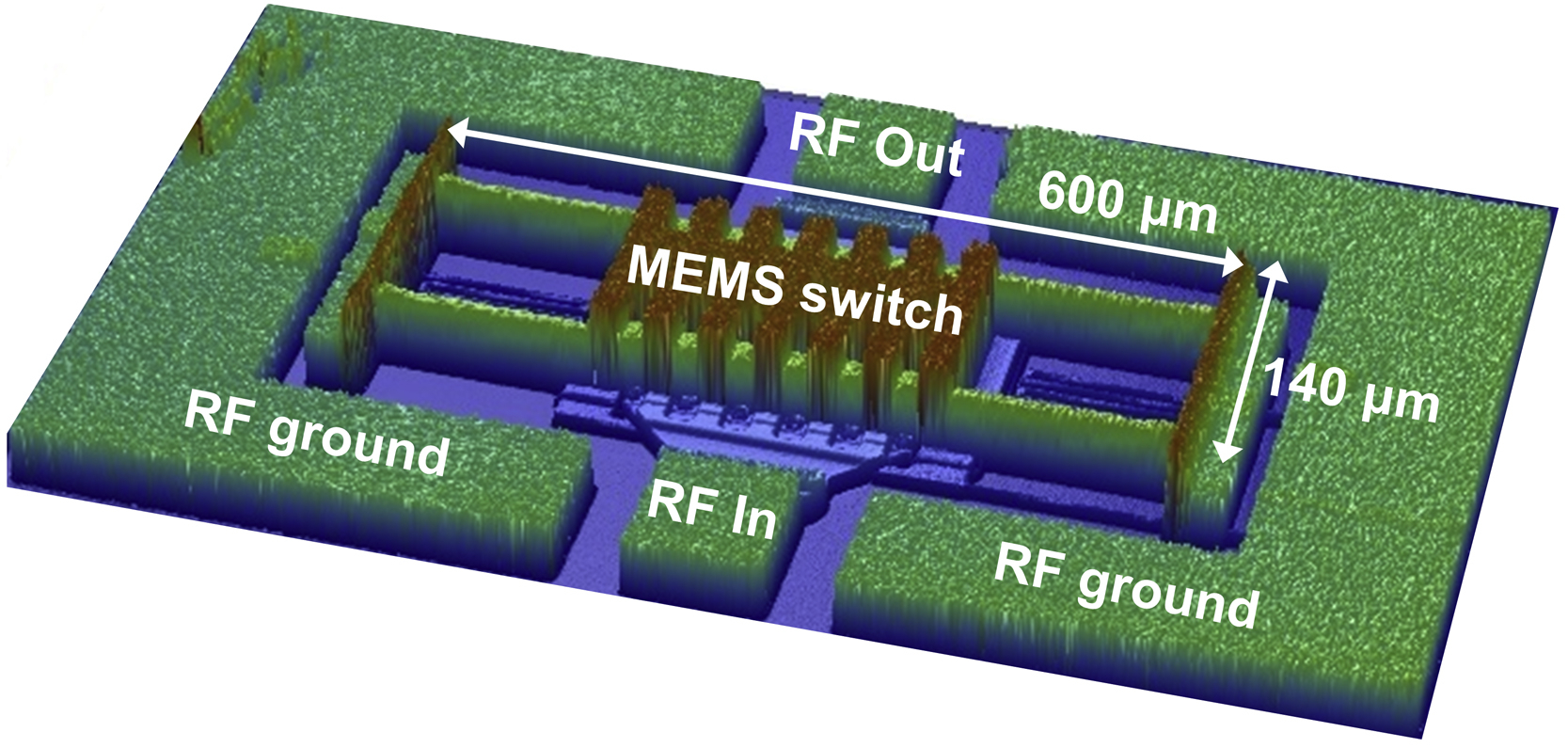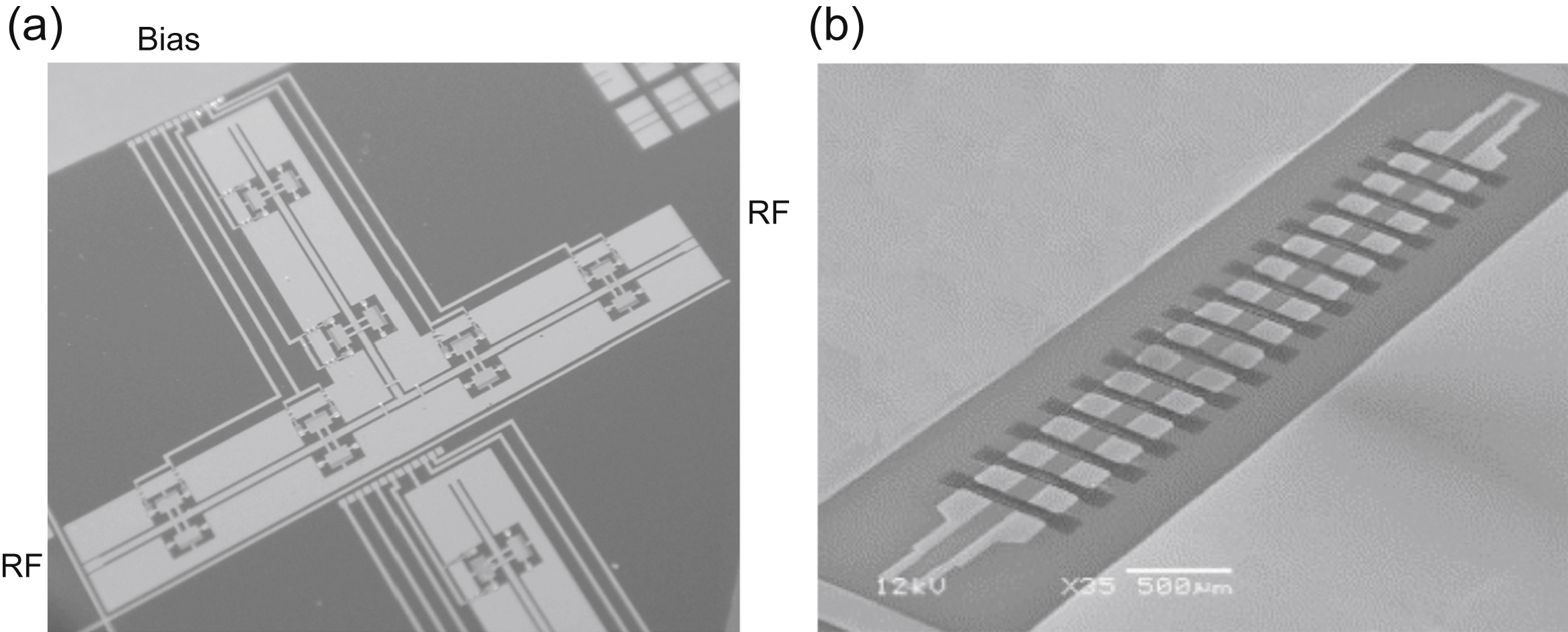Allan R. RF MEMS Switches are Primed for Mass-Market Applications. 2003. http://mwrf.com/active-components/rf-mems-switches-are-primed-mass-market-applications.
Baldemair R, Irnich T, Balachandran K, Dahlman E, Mildh G, Selén Y, Parkvall S, Meyer M, Osseiran A. Ultra-dense networks in millimeter-wave frequencies. IEEE Communications Magazine. 2015;53(1):202–208. doi: 10.1109/MCOM.2015.7010535.
Bhushan N, Li J, Malladi D, Gilmore R, Brenner D, Damnjanovic A, Sukhavasi R.T, Patel C, Geirhofer S. Network densification: the dominant theme for wireless evolution into 5G. IEEE Communications Magazine. 2014;52(2):82–89. doi: 10.1109/MCOM.2014.6736747.
Boccardi F, Heath R.W, Lozano A, Marzetta T.L, Popovski P. Five disruptive technology directions for 5G. IEEE Communications Magazine. 2014;52(2):74–80. doi: 10.1109/MCOM.2014.6736746.
Bordas C, Grenier K, Dubuc D, Flahaut E, Pacchini S, Paillard M, Cazaux J.-L. Carbon nanotube based dielectric for enhanced RF MEMS reliability. In: Proceedings of the IEEE MTT-S International Microwave Symposium, Honolulu, HI, USA, 3–8 June, 2007. 2007:375–378. doi: 10.1109/MWSYM.2007.380449. .
Bouyge D, Crunteanu A, Durán-Sindreu M, Pothier A, Blondy P, Bonachel J, Orlianges J.-C, Martin F. Reconfigurable split rings based on MEMS switches and their application to tunable filters IOP. Journal of Optics. 2012;14(11):1–9. http://iopscience.iop.org/2040-8986/14/11/114001.
Cavendish Kinetics, Cavendish Kinetics Adds Design Wins and Ramps Shipments of RF MEMS Tuners. 2015. http://www.cavendish-kinetics.com/release/cavendish-kinetics-adds-design-wins-and-ramps-shipments-of-rf-mems-tuners/.
Cavendish Kinetics, Nubia Adopts Cavendish Kinetics' SmarTune Antenna Tuning Solution for its New Z7 LTE Smartphone. 2014. http://www.cavendish-kinetics.com/news/news-releases/.
Chaabane G, Pothier A, Chatras M, Guines C, Madrangeas V, Blondy P. A 2-pole RF-MEMS tunable bandpass filter for high-power applications. In: Proceedings of the 44th European Microwave Conference, Rome, Italy, 6–9 October, 2014. 2014:343–346. doi: 10.1109/EuMC.2014.6986440.
Chan K.Y, Ramer R, Mansour R.R. A switchable Iris bandpass filter using RF MEMS switchable planar resonators. IEEE Microwave and Wireless Components Letters. 2017;27(1):34–36. doi: 10.1109/LMWC.2016.2629960.
Chen B, Sekhar V.N, Jin C, Lim Y.Y, Toh J.S, Fernando S, Sharma J. Low-loss broadband package platform with surface passivation and TSV for wafer-level packaging of RF-MEMS devices. IEEE Transactions on Components, Packaging and Manufacturing Technology. 2013;3(9):1443–1452. doi: 10.1109/TCPMT.2013.2263932.
Chiao M, Cheng Y.-T, Lin L. Introduction to MEMS packaging. In: Zhou Z, Wang Z, Lin L, eds. Microsystems and Nanotechnology. Berlin: Springer; 2012:415–446. doi: 10.1007/978-3-642-18293-8_11.
Cho I.-J, Song T, Baek S.-H, Yoon E. A low-voltage and low-power RF MEMS series and shunt switches actuated by combination of electromagnetic and electrostatic forces. IEEE Transactions on Microwave Theory and Techniques. 2005;53(7):2450–2457. doi: 10.1109/TMTT.2005.850406.
Cohn M.B, Roehnelt R, Xu J.-H, Shteinberg A, Cheung S. MEMS packaging on a budget (fiscal and thermal). In: Proceedings of the 9th International Conference on Electronics, Circuits and Systems ICECS, Dubrovnik, Croatia, 15–18 September, 2002. vol. 1. 2002:287–290. doi: 10.1109/ICECS.2002.1045390.
Contreras A, Ribo M, Pradell L, Casals-Terre J, Giacomozzi F, Iannacci J. K-band RF-MEMS uniplanar reconfigurable-bandwidth bandpass filter using multimodal immittance inverters. IET Electronics Letters. 2013;49(11):1–2. doi: 10.1049/el.2013.0681.
Contreras A, Casals-Terre J, Pradell L, Giacomozzi F, Iannacci J, Ribo M. A Ku-band RF-MEMS frequency reconfigurable multimodal bandpass filter Cambridge University Press. International Journal of Microwave and Wireless Technologies. 2014:1–9. doi: 10.1017/S1759078714000567.
Cost-Effective Wafer-Level Integrated Passive Devices (WL-IPD) Technology for RF Applications. 2014. https://www.altissemiconductor.com/fr/images/altis/about-altis/ALTIS_Insights_3.pdf.
Daneshmand M, Fouladi S, Mansour R.R, Lisi M, Stajcer T. Thermally actuated latching RF MEMS switch and its characteristics. IEEE Transactions on Microwave Theory and Techniques. 2009;57(12):3229–3238. doi: 10.1109/TMTT.2009.2033866. .
De Graauw A.j.m, Steeneken P.G, Chanlo C, Dijkhuis J, Pramm S, Van Bezooijen A, ten Dolle H.K.J, Van Straten F, Lok P. MEMS-based reconfigurable multi-band BiCMOS power amplifier. In: Proceedings of the 2006 Bipolar/BiCMOS Circuits and Technology Meeting, Maastricht, the Netherlands, 8–10 October, 2006. 2006:1–4. doi: 10.1109/BIPOL.2006.311134.
De Silva A.P, Hughes H.G. The package integration of RF-MEMS switch and control IC for wireless applications. IEEE Transactions on Advanced Packaging. 2003;26(3):255–260. doi: 10.1109/TADVP.2003.818056.
DeNatale J, Mihailovich R. RF MEMS reliability. In: Proceedings of the 12th International Conference on Solid-State Sensors, Actuators and Microsystems TRANSDUCERS, Boston, MA, USA, 8–12 June, 2003. vol. 2. 2003:943–946. doi: 10.1109/SENSOR.2003.1216922.
Dohler M. The tactile internet IoT, 5G and cloud on steroids. In: Proceedings of 5G Radio Technology Seminar. Exploring Technical Challenges in the Emerging 5G Ecosystem, London, 17 March, 2015. 2015:1–16. doi: 10.1049/ic.2015.0029.
Dubuc D, Rabbia L, Grenier K, Pons P, Vendier O, Graffeuil J, Plana R. Original MEMS-based single pole double throw topology for millimeter wave space communications. In: Proceedings of the 33rd European Microwave Conference, Munich, Germany, 2–10 October, 2003. 2003:979–982. doi: 10.1109/EUMA.2003.341127.
Ducarouge B, Dubuc D, Melle S, Bary L, Pons P, Plana R. Efficient design methodology of polymer based RF MEMS switches. In: Proceedings of the Topical Meeting on Silicon Monolithic Integrated Circuits in RF Systems(SiRF), Atlanta, USA, 8–10 September, 2004. 2004:298–301. doi: 10.1109/SMIC.2004.1398228.
Ehmke J.C, Goldsmith C.L, Yao Z.J, Eshelman S.M. Method and Apparatus for Switching High Frequency Signals Patent No: US 6,391,675 B1. 2002.
Fall M, Fouladi S, Domingue F, Dieppedale C, Reig B, Mansour R.R. High capacitance ratio RF MEMS dielectric-less switched capacitor. In: Proceedings of the European Microwave Conference, Nuremberg, Germany, 6–10 October, 2013. 2013:1327–1330.
Fedder G.K, Howe R.T, Liu T.J.K, Quevy E.P. Technologies for cofabricating MEMS and electronics. Proceedings of the IEEE. 2008;96(2):306–322. doi: 10.1109/JPROC.2007.911064.
Festo A.E, Folgero K, Ullaland K, Gjertsen K.M. A six bit, 6–18 GHz, RF-MEMS impedance tuner for 50 Ω systems. In: Proceedings of the European Microwave Conference (EuMC), Rome, Italy, 29 September–1 October, 2009. 2009:1132–1135.
Fettweis G.P. The tactile internet: applications and challenges. IEEE Vehicular Technology Magazine. 2014;9(1):64–70. doi: 10.1109/MVT.2013.2295069.
Figur S.A, Meniconi E, Prechtel U, Ziegler V, Schoenlinner B, Sorrentino R, Vietzorreck L. Design and characterization of a simplified planar 16×8 RF MEMS switch matrix for a GEO-stationary data relay. In: Proceedings of the 42nd European Microwave Conference, Amsterdam, the Netherlands, 29 October–1 November, 2012. 2012:1059–1062.
Figur S.A, Ziegler V, van Raay F, Quay R, Vietzorreck L. RF MEMS variable matching networks for multi-band and multi-mode GaN power amplifiers. In: Proceedings of the European Microwave Integrated Circuit Conference, Nuremberg, Germany, 6–8 October, 2013. 2013:324–327.
Fischer A.C, Forsberg F, Lapisa M, Bleiker S.J, Stemme G, Roxhed N, Niklaus F. Integrating MEMS and ICs. Microsystems and Nanoengineering. 2015;1:15005 Available from:. https://doi.org/10.1038/micronano.2015.5. .
Fouladi S, Domingue F, Mansour R. CMOS-MEMS tuning and impedance matching circuits for reconfigurable RF front-ends. In: Proceedings of the IEEE MTT-S International Microwave Symposium, Montreal, QC, Canada, 17–22 June, 2012. 2012:1–3. doi: 10.1109/MWSYM.2012.6259776.
Fukuda A, Okazaki H, Hirota T, Yamao Y. Novel 900 MHz/1.9 GHz dual-mode power amplifier employing MEMS switches for optimum matching. IEEE Microwave and Wireless Components Letters. 2004;14(3):121–123. doi: 10.1109/LMWC.2003.821496.
Giacomozzi F, Iannacci J. RF MEMS technology for next-generation wireless communications. In: Uttamchandani D, ed. Handbook of MEMS for Wireless and Mobile Applications. first ed. Sawston: Woodhead Publishing; 2013 doi: 10.1533/9780857098610.1.225 (Chapter 8).
Giacomozzi F, Mulloni V, Colpo S, Iannacci J, Margesin B, Faes A. A flexible fabrication process for RF MEMS devices. Romanian Journal of Information Science and Technology. 2011;14(3):259–268.
Gillot C, Lagoutte E, Charvet P.L, Souchon F, Sillon N. Wafer level thin film encapsulation for MEMS. In: Proceedings of the Conference on High Density Microsystem Design and Packaging and Component Failure Analysis, Shanghai, 27–29 June, 2005. 2005:1–4. doi: 10.1109/HDP.2005.251432.
Goldsmith C, Lin T.-H, Powers B, Wu W.-R, Norvell B. Micromechanical membrane switches for microwave applications. In: Proceedings of the IEEE MTT-S International Microwave Symposium, Orlando, FL, USA, 16–20 May, 1995. vol. 1. 1995:91–94. doi: 10.1109/MWSYM.1995.406090.
Goldsmith C, Randall J, Eshelman S, Lin T.-H, Denniston D, Chen S, Norvell B. Characteristics of micromachined switches at microwave frequencies. In: Proceedings of the IEEE MTT-S International Microwave Symposium, San Francisco, CA, USA, 17–21 June, 1996. vol. 2. 1996:1141–1144. doi: 10.1109/MWSYM.1996.511231.
Grenier K, Dubuc D, Mazenq L, Ducarouge B, Bouchriha F, Rennane A, Pons P, Plana R, Busquere J.-P, Lubecke V, Ancey P. Polymer based technologies for microwave and millimeterwave applications. In: Proceedings of the IEEE International Electron Devices Meeting IEDM, Washington, USA, 13–15 December, 2004. 2004:545–548. doi: 10.1109/IEDM.2004.1419216.
Grenier K, Dubuc D, Ducarouge B, Conedera V, Bourrier D, Ongareau E, Derderian P, Plana R. High power handling RF MEMS design and technology. In: Proceedings of the 18th IEEE International Conference on Micro Electro Mechanical Systems MEMS, Miami, USA, 30 January–3 February 2005. 2005:155–158. doi: 10.1109/MEMSYS.2005.1453890.
Guo X, Gong Z, Zhong Q, Liang X, Liu Z. A miniaturized reconfigurable broadband attenuator based on RF MEMS switches IOP. Journal of Micromechanics and Microengineering. 2016;26(7):1–8. doi: 10.1088/0960-1317/26/7/074002.
Hacker J.B, Kim M, Mihailovich R.E, DeNatale J.F. Monolithic GaAs PHEMT MMICs integrated with RF MEMS switches. In: Proceedings of the IEEE Compound Semiconductor Integrated Circuit Symposium, Monterey, USA, 24–27 October, 2004. 2004:229–232. doi: 10.1109/CSICS.2004.1392546.
Halg B. On a micro-electro-mechanical nonvolatile memory cell. IEEE Transactions on Electron Devices. 1990;37(10):2230–2236. doi: 10.1109/16.59913.
Hickle M.D, Li J, Psychogiou D, Peroulis D. A high-performance pathway: a 0.95/2.45-GHZ switched-frequency bandpass filter using commercially available RF MEMS tuning elements. IEEE Microwave Magazine. 2016;17(3):34–41. doi: 10.1109/MMM.2015.2505701. .
Iannacci J, Bartek M. Electromagnetic optimisation of an RF-MEMS wafer-level package. In: Proceedings of the 20th European Conference on Solid-State Transducers Eurosensors XX, Goteborg, Sweden, 17–20 September, 2006. 2006:1–4.
Iannacci J, Tian J, Sosin S, Gaddi R, Bartek M. Hybrid wafer-level packaging for RF MEMS applications. In: Proceedings of the International Wafer-Level Packaging Conference IWLPC, San Jose, CA, USA, 1–3 November, 2006. 2006:106–113.
Iannacci J, Bartek M, Tian J, Gaddi R, Gnudi A. Electromagnetic optimization of an RF-MEMS wafer-level package Elsevier. Sensors and Actuators A: Physical. 2008;142(1):434–441. doi: 10.1016/j.sna.2007.08.018.
Iannacci J, Gnudi A, Margesin B, Giacomozzi F, Larcher L, Brama R. Reconfigurable RF MEMS based impedance matching network for a CMOS power amplifier. In: Proceedings of the 9th International Symposium on RF MEMS and RF Microsystems MEMSWAVE, Heraklion, Greece, 30 June–3 July, 2008. 2008:1–4.
Iannacci J, Giacomozzi F, Colpo S, Margesin B, Bartek M. A general purpose reconfigurable MEMS-based attenuator for radio frequency and microwave applications. In: Proceedings of the IEEE Region 8 EUROCON Conference, Saint Petersburg, Russia, 18–23 May, 2009. 2009:1201–1209. doi: 10.1109/EURCON.2009.5167788.
Iannacci J, Gaddi R, Gnudi A. Experimental validation of mixed electromechanical and electromagnetic modeling of RF-MEMS devices within a standard IC simulation environment. IEEE Journal of Microelectromechanical Systems. 2010;19(3):526–537. doi: 10.1109/JMEMS.2010.2048417.
Iannacci J, Repchankova A, Faes A, Tazzoli A, Meneghesso G, Dalla Betta G.-F. Enhancement of RF-MEMS switch reliability through an active anti-stiction heat-based mechanism Elsevier. Microelectronics Reliability. 2010;50(9–11):1599–1603. doi: 10.1016/j.microrel.2010.07.108.
Iannacci J, Masotti D, Kuenzig T, Niessner M. A reconfigurable impedance matching network entirely manufactured in RF-MEMS technology. In: Proceedings of the SPIE Microtechnologies Conference, Prague, Czech Republic, 18–20 April, 2011. vol. 8066. 2011:1–12. doi: 10.1117/12.886186.
Iannacci J, Faes A, Repchankova A, Tazzoli A, Meneghesso G. An active heat-based restoring mechanism for improving the reliability of RF-MEMS switches Elsevier. Microelectronics Reliability. 2011;51(9–11):1869–1873. doi: 10.1016/j.microrel.2011.06.019.
Iannacci J, Resta G, Farinelli P, Sorrentino R. RF-MEMS components and networks for high-performance reconfigurable telecommunication and wireless systems Trans Tech Publications. Advances in Science and Technology. 2012;81:65–74. 10.4028/www.scientific.net/AST.81.65.
Iannacci J, Huhn M, Tschoban C, Potter H. RF-MEMS technology for 5G: series and shunt attenuator modules demonstrated up to 110 GHz. IEEE Electron Device Letters. 2016;37(10):1336–1339. doi: 10.1109/LED.2016.2604426.
Iannacci J. Practical Guide to RF-MEMS. first ed. Weinheim: Wiley-VCH; 2013.
Iannacci J. RF passive components for wireless applications. In: Uttamchandani D, ed. Handbook of MEMS for Wireless and Mobile Applications. first ed. Sawston: Woodhead Publishing; 2013 doi: 10.1533/9780857098610.1.100 (Chapter 4).
Iannacci J. RF-MEMS: an enabling technology for modern wireless systems bearing a market potential still not fully displayed Springer. Microsystem Technologies. 2015;21(10):2039–2052. doi: 10.1007/s00542-015-2665-6. .
Iannacci J. Reliability of MEMS: a perspective on failure mechanisms, improvement solutions and best practices at development level Elsevier. Displays. 2015;37:62–71. https://doi.org/10.1016/j.displa.2014.08.003.
IHS iSuppli. IHS iSuppli Teardown Analysis Service Identifies First Use of RF MEMS Part, Set to be Next Big Thing in Cellphone Radios. 2012. http://press.ihs.com/press-release/design-supply-chain/ihs-isuppli-teardown-analysis-service-identifies-first-use-rf-mems.
Internet of Things. 2016. http://blog.econocom.com/en/blog/category/trends/internet-of-things-en/.
Jacobs School of Engineering. RF MEMS: New Possibilities for Smartphones. 2014. http://jacobsschool.ucsd.edu/pulse/winter2014/page5.sfe.
Jandhyala V, Sathanur A, Chakraborty R. Towards automated optimization, multidimensional parametrization, and synthesis with electromagnetic solvers in electronic packaging and RF circuit design. In: Proceedings of the International Conference on Electromagnetics in Advanced Applications, Torino, Italy, 14–18 September, 2009. 2009:133–136. doi: 10.1109/ICEAA.2009.5297565.
Jin Y, Wang Z, Chen J. Introduction to Microsystem Packaging Technology. first ed. Boca Raton: CRC Press; 2010.
Jourdain A, Ziad H, De Moor P, Tilmans H.A.C. Wafer-scale 0-level packaging of (RF-)MEMS devices using BCB. In: Proceedings of the Symposium on Design, Test, Integration and Packaging of MEMS/MOEMS DTIP, Mandelieu–La Napoule, France, 5–7 May, 2003. 2003:239–244. doi: 10.1109/DTIP.2003.1287044.
Jourdain A, Rottenberg X, Carchon G, Tilmans H.A.C. Optimization of 0-level packaging for RF-MEMS devices. In: Proceedings of the 12th International Conference on Solid-State Sensors, Actuators and Microsystems, TRANSDUCERS, Boston, MA, USA, 8–12 June, 2003. 2003:1915–1918. doi: 10.1109/SENSOR.2003.1217166 2.
Kawakubo T, Nagano T, Nishigaki M, Abe K, Itaya K. Piezoelectric RF MEMS tunable capacitor with 3V operation using CMOS compatible materials and process. In: Proceedings of the IEEE International Electron Devices Meeting IEDM, Washington, DC, USA, 5 December, 2005. 2005:294–297. doi: 10.1109/IEDM.2005.1609332.
Kim M, Hacker J.B, Mihailovich R.E, DeNatale J.F. A monolithic MEMS switched dual-path power amplifier. IEEE Microwave and Wireless Components Letters. 2001;11(7):285–286. doi: 10.1109/7260.933772.
Kim T.H, Jeung W.K, Yang S.J, Choi S.M, Park S.W, Kim H.H, Ha J, Park M.J, Kao S, Hong J.P, Yi S, Hwang J.S, Lim J.H, Kim W.B. Miniaturization and optimization of RF SAW filter using wafer level packaging technology. In: Proceedings of the 57th Electronic Components and Technology Conference, Reno, NV, USA, 29 May–1 June, 2007. 2007:574–579. doi: 10.1109/ECTC.2007.373853.
Kuang K, Kim F, Cahill S.S, eds. RF and Microwave Microelectronics Packaging. first ed. Berlin: Springer; 2010.
Lahti M, Kautio K, Ollila J, Vähä-Heikkilä T, Kaunisto M. Hermetic packaging for millimetre wave applications. In: Proceedings of the European Microelectronics Packaging Conference EMPC, Grenoble, France, 9–12 September, 2013. 2013:1–5.
Lapedus M. Inside the 5G Smartphone. 2015. http://semiengineering.com/inside-the-5g-smartphone/.
Larcher L, Brama R, Ganzerli M, Iannacci J, Margesin B, Bedani M, Gnudi A. A MEMS reconfigurable quad-band class-e power amplifier for GSM standard. In: Proceedings of the 22nd IEEE International Conference on Micro Electro Mechanical Systems MEMS, Sorrento, Italy, 25–29 January, 2009. 2009:864–867. doi: 10.1109/MEMSYS.2009.4805520. .
Larson L.E, Hackett R.H, Melendes M.A, Lohr R.F. Micromachined microwave actuator (MIMAC) technology-a new tuning approach for microwave integrated circuits. In: Proceedings of the IEEE Microwave and Millimeter-Wave Monolithic Circuits Symposium, Boston, MA, USA, 10–11 June, 1991. 1991:27–30. doi: 10.1109/MCS.1991.148080.
Lau J.H, Lee C.K, Premachandran C.S, Aibin Y. Advanced MEMS Packaging. first ed. New York: McGraw-Hill Education; 2010.
Le L.B, Lau V, Jorswieck E, Dao N.-D, Haghighat A, Kim D.I, Le-Ngoc T. Enabling 5G mobile wireless technologies. EURASIP Journal on Wireless Communications and Networking. 2015:1–14. doi: 10.1186/s13638-015-0452-9.
Li J, Hickle M, Psychogiou D, Peroulis D. A compact L-band bandpass filter with RF MEMS-enabled reconfigurable notches for interference rejection in GPS applications. IEEE Microwave Magazine. 2015;16(1):81–88. doi: 10.1109/MMM.2014.2367861.
Lisec T, Huth C, Wagner B. Dielectric material impact on capacitive RF MEMS reliability. In: Proceedings of the 34th European Microwave Conference, Amsterdam, the Netherlands, 12–14 October, 2004. 2004:73–76.
Liu R, Schreurs D, Raedt W.D, Vanaverbeke F, Mertens R. RF-MEMS based tri-band GaN power amplifier. IET Electronics Letters. 2011;47(13):762–763. doi: 10.1049/el.2011.1627.
Liu Y, Bey Y, Liu X. Single-actuator shunt-series RF-MEMS switch. In: Proceedings of the IEEE MTT-S International Microwave Symposium (IMS2014), Tampa, FL, USA, 1–6 June, 2014. 2014:1–4. doi: 10.1109/MWSYM.2014.6848666.
Lu Y, Peroulis D, Mohammadi S, Katehi L.P.B. A MEMS reconfigurable matching network for a class AB amplifier. IEEE Microwave and Wireless Components Letters. 2003;13(10):437–439. doi: 10.1109/LMWC.2003.818523.
Lu A.C.W, Chua K.M, Guo L.H. Emerging manufacturing technologies for RFIC, antenna and RF-MEMS integration. In: Proceedings of the IEEE International Workshop on Radio-Frequency Integration Technology: Integrated Circuits for Wideband Communications & Wireless Sensor Networks, Singapore, 30 November – 2 December, 2005. 2005:142–146. doi: 10.1109/RFIT.2005.1598895.
Lu Y, Katehi L.P.B, Peroulis D. High-power MEMS varactors and impedance tuners for millimeter-wave applications. IEEE Transactions on Microwave Theory and Techniques. 2005;53(11):3672–3678. doi: 10.1109/TMTT.2005.859031.
Malmqvist R, Samuelsson C, Gustafsson A, Maher H, Vähä-Heikkilä T, Baggen R. A K-band single-chip reconfigurable/multi-functional RF-MEMS switched dual-LNA MMIC. In: Proceedings of the IEEE MTT-S International Microwave Symposium, Montreal, QC, Canada, 17–22 June, 2012. 2012:1–3. doi: 10.1109/MWSYM.2012.6259517.
Mardivirin D, Pothier A, Khatib M.E, Crunteanu A, Vendier O, Blondy P. Reliability of dielectric less electrostatic actuators in RF-MEMS ohmic switches. In: Proceedings of the European Microwave Integrated Circuit Conference, Amsterdam, the Netherlands, 27–28 October, 2008. 2008:490–493. doi: 10.1109/EMICC.2008.4772336.
Mardivirin D, Pothier A, Orlianges J.C, Crunteanu A, Blondy P. Charging acceleration in dielectric less RF MEMS switched varactors under CW microwave power. In: Proceedings of the IEEE International Microwave Symposium MTT-s, Boston, MA, USA, 7–12 June, 2009. 2009:1649–1652. doi: 10.1109/MWSYM.2009.5166030. .
Margomenos A, Katehi L.P.B. DC to 40 GHz on-wafer package for RF MEMS switches. In: Proceedings of the IEEE 11th Topical Meeting on Electrical Performance of Electronic Packaging, Monterey, CA, USA, 21–23 October, 2002. 2002:91–94. doi: 10.1109/EPEP.2002.1057890.
Margomenos A, Katehi L.P.B. High frequency parasitic effects for on-wafer packaging of RF MEMS switches. In: Proceedings of the IEEE MTT-s International Microwave Symposium, Philadelphia, PA, USA, 8–13 June, 2003. vol. 3. 2003:1931–1934. doi: 10.1109/MWSYM.2003.1210536.
Martin M.J.C. Managing Innovation and Entrepreneurship in Technology-Based Firms. first ed. Hoboken: John Wiley & Sons; 1994.
Melle S, Flourens F, Dubuc D, Grenier K, Pons P, Pressecq F, Kuchenbecker J, Muraro J.L, Bary L, Plana R. Reliability overview of RF MEMS devices and circuits. In: Proceedings of the 33rd European Microwave Conference, 2003, Munich, Germany, 2–10 October, 2003. 2003:37–40. doi: 10.1109/EUMA.2003.340820.
Melle S, De Conto D, Dubuc D, Grenier K, Vendier O, Muraro J.-L, Cazaux J.-L, Plana R. Reliability modeling of capacitive RF MEMS. IEEE Transactions on Microwave Theory and Techniques. 2005;53(11):3482–3488. doi: 10.1109/TMTT.2005.857109.
Moon J-s, Seo H-c, Le D. Development toward high-power sub-1-ohm DC-67 GHz RF switches using phase change materials for reconfigurable RF front-end. In: Proceedings of the IEEE MTT-S International Microwave Symposium (IMS2014), Tampa, FL, USA, 1–6 June, 2014. 2014:1–3. doi: 10.1109/MWSYM.2014.6848334.
Morris A.S, Natarajan S.P, Gu Q, Steel V. Impedance tuners for handsets utilizing high-volume RF-MEMS. In: Proceedings of the 42nd European Microwave Conference, Amsterdam, the Netherlands, 29 October–1 November, 2012. 2012:193–196.
Muldavin J.B, Rebeiz G.M. 30 GHz tuned MEMS switches. In: Proceedings of the IEEE MTT-S International Microwave Symposium, Anaheim, CA, USA, 13–19 June, 1999. vol. 4. 1999:1511–1514. doi: 10.1109/MWSYM.1999.780241.
Muldavin J, Boisvert R, Bozler C, Rabe S, Keast C. Power handling and linearity of MEM capacitive series switches. In: Proceedings of the IEEE MTT-S International Microwave Symposium, Philadelphia, PA, USA, 8–13 June, 2003. vol. 3. 2003:1915–1918. doi: 10.1109/MWSYM.2003.1210532.
Nguyen C.T.C. Transceiver front-end architectures using vibrating micromechanical signal processors. In: Proceedings of the Topical Meeting on Silicon Monolithic Integrated Circuits in RF Systems, Ann Arbor, MI, USA, 14 September, 2001. 2001:23–32. doi: 10.1109/SMIC.2001.942335.
Nguyen C.T.C. Integrated micromechanical radio front-ends. In: Proceedings of the International Symposium on VLSI Technology, Systems and Applications VLSI-TSA, Hsinchu, China, 21–23 April, 2008. 2008:3–4. doi: 10.1109/VTSA.2008.4530773.
Oberhammer J, Tang M, Liu A.Q, Stemme G. Mechanically tri-stable in-line single-pole-double-throw all-metal switch. In: Proceedings of the 19th IEEE International Conference on Micro Electro Mechanical Systems, Istanbul, Turkey, 22–26 January, 2006. 2006:898–901. doi: 10.1109/MEMSYS.2006.1627945.
Osseiran A, Boccardi F, Braun V, Kusume K, Marsch P, Maternia M, Queseth O, Schellmann M, Schotten H, Taoka H, Tullberg H, Uusitalo M.A, Timus B, Fallgren M. Scenarios for 5G mobile and wireless communications: the vision of the METIS project. IEEE Communications Magazine. 2014;52(5):26–35. doi: 10.1109/MCOM.2014.6815890. .
Pacheco S, Nguyen C.T, Katehi L.P.B. Micromechanical electrostatic K-band switches. In: Proceedings of the IEEE MTT-S International Microwave Symposium, Baltimore, MD, USA, 7–12 June, 1998. vol. 3. 1998:1569–1572. doi: 10.1109/MWSYM.1998.700675.
Pacheco S.P, Peroulis D, Katehi L.P.B. MEMS single-pole double-throw (SPDT) X and K-band switching circuits. In: Proceedings of the IEEE MTT-s International Microwave Symposium, Phoenix, AZ, USA, 20–24 May, 2001. vol. 1. 2001:321–324. doi: 10.1109/MWSYM.2001.966897.
Pacheco S, Zurcher P, Young S, Weston D, Dauksher W. RF MEMS resonator for CMOS back-end-of-line integration. In: Proceedings of the Topical Meeting on Silicon Monolithic Integrated Circuits in RF Systems, Atlanta, GA, USA, 8–10 September, 2004. 2004:203–206. doi: 10.1109/SMIC.2004.1398203.
Palego C, Solazzi F, Halder S, Hwang J.C.M, Farinelli P, Sorrentino R, Faes A, Mulloni V, Margesin B. Effect of substrate on temperature range and power capacity of RF MEMS capacitive switches. In: Proceedings of the European Microwave Conference EuMC, Paris, France, 28–30 September, 2010. 2010:505–508.
Palei W, Liu A.Q, Yu A.B, Alphones A, Lee Y.H. Optimization of design and fabrication for micromachined true time delay (TTD) phase shifters Elsevier. Sensors and Actuators A: Physical. 2005;119(2):446–454. https://doi.org/10.1016/j.sna.2004.10.006.
Park Y.-K, Park H.-W, Lee D.-J, Park J.-H, Song I.-S, Kim C.-W, Song C.-M, Lee Y.-H, Kim C.-J, Ju B.K. A novel low-loss wafer-level packaging of the RF-MEMS devices. In: Proceedings of the 15th IEEE Micro Electro Mechanical Systems MEMS International Conference, Las Vegas, NV, USA, 20–24 January, 2002. 2002:681–684. doi: 10.1109/MEMSYS.2002.984362.
Park Y.-K, Kim Y-k, Kim H, Lee D.-J, Kim C.-J, Ju B.-K, Park J.-O. A novel thin chip scale packaging of the RF-MEMS devices using ultra thin silicon. In: Proceedings of the 16th IEEE Micro Electro Mechanical Systems MEMS International Conference, Kyoto, Japan, 19–23 January, 2003. 2003:618–621. doi: 10.1109/MEMSYS.2003.1189825.
Persano A, Lucibello A, Marcelli R, Capoccia G, Proietti E, Bagolini A, Iannacci J, Siciliano P, Quaranta F. Wafer-level thin film micropackaging for RF MEMS applications. In: Proceedings of the Symposium on Design, Test, Integration and Packaging of MEMS and MOEMS (DTIP), Budapest, Hungary, 30 May–2 June, 2016. 2016:1–5. doi: 10.1109/DTIP.2016.7514826.
Petersen K.E. Micromechanical membrane switches on silicon. IBM Journal of Research Development. 1975;23(4):376–385. doi: 10.1147/rd.234.0376.
Pillans B, Kleber J, Goldsmith C, Eberly M. RF power handling of capacitive RF MEMS devices. In: Proceedings of the IEEE MTT-S International Microwave Symposium, Seattle, WA, USA, 2–7 June, 2002. vol. 1. 2002:329–332. doi: 10.1109/MWSYM.2002.1011623.
Qiao D, Molfino R, Lardizabal S.M, Pillans B, Asbeck P.M, Jerinic G. An intelligently controlled RF power amplifier with a reconfigurable MEMS-varactor tuner. IEEE Transactions on Microwave Theory and Techniques. 2005;53(3):1089–1095. doi: 10.1109/TMTT.2005.843495.
Rantakari P, Malmqvist R, Samuelsson C, Leblanc R, Smith D, Jonsson R, Simon W, Saijets J, Baggen R, Vaha-Heikkia T. Wide-band radio frequency micro electro-mechanical systems switches and switching networks using a gallium arsenide monolithic microwave-integrated circuits foundry process technology. IET Microwaves, Antennas and Propagation. 2011;5(8):948–955. doi: 10.1049/iet-map.2010.0434. .
Rebeiz G.M, Muldavin J.B. RF MEMS switches and switch circuits. IEEE Microwave Magazine. 2001;2(4):59–71. doi: 10.1109/6668.969936.
Rebeiz G.M. RF Mems: Theory, Design and Technology. first ed. Hoboken: John Wiley & Sons; 2003.
Reinke J, Fedder G.K, Mukherjee T. CMOS-MEMS 3-bit digital capacitors with tuning ratios greater than 60:1. IEEE Transactions on Microwave Theory and Techniques. 2011;59(5):1238–1248. doi: 10.1109/TMTT.2011.2114363.
Repchankova A, Iannacci J. Heat-based recovery mechanism to counteract stiction of RF-MEMS switches. In: Proceedings of Symposium on Design, Test, Integration and Packaging of MEMS and MOEMS (DTIP), Rome, Italy, 1–3 April, 2009. 2009:176–181.
Rijks T.G.S.M, van Beek J.T.M, Ulenaers M.J.E, De Coster J, Puers R, den Dekker A, van Teeffelen L. Passive integration and RF MEMS: a toolkit for adaptive LC circuits. In: Proceedings of the 29th European Solid-State Circuits Conference ESSCIRC, Estoril, Portugal, 16–18 September, 2003. 2003:269–272. doi: 10.1109/ESSCIRC.2003.1257124.
Rizk J.B, Chaiban E, Rebeiz G.M. Steady state thermal analysis and high-power reliability considerations of RF MEMS capacitive switches. In: Proceedings of the IEEE MTT-S International Microwave Symposium, Seattle, WA, USA, 2–7 June, 2002. vol. 1. 2002:239–243. doi: 10.1109/MWSYM.2002.1011602.
Sekhar V.N, Toh J.S, Cheng J, Sharma J, Fernando S, Bangtao C. Wafer level packaging of RF MEMS devices using TSV interposer technology. In: 2012 Proceedings of the 14th Electronics Packaging Technology Conference (EPTC), Singapore, 5–7 December, 2012. 2012:231–235. doi: 10.1109/EPTC.2012.6507083.
Seki T, Yamamoto J, Murakami A, Yoshitake N, Hinuma K-i, Fujiwara T, Sano K, Matsushita T, Sato F, Oba M. An RF MEMS switch for 4G front-ends. In: Proceedings of the IEEE International Microwave Symposium MTT-S, Seattle, WA, USA, 2–7 June, 2013. 2013:1–3. doi: 10.1109/MWSYM.2013.6697501.
Seki T. Recent progress in packaging of RF MEMS. In: Proceedings of the IEEE Compound Semiconductor Integrated Circuit Symposium, Monterey, USA, 24–27 October, 2004. 2004:233–236. doi: 10.1109/CSICS.2004.1392547.
Shah U, Decrossas E, Jung-Kubiak C, Reck T, Chattopadhyay G, Mehdi I, Oberhammer J. Submillimeter-wave 3.3-bit RF MEMS phase shifter integrated in micromachined waveguide. IEEE Transactions on Terahertz Science and Technology. 2016;6(5):706–715. doi: 10.1109/TTHZ.2016.2584924.
Sharma A.K, Gupta N. Impedance matching for RF-MEMS based microstrip patch antenna. In: Proceedings of the 11th International Conference on Electrical Engineering/Electronics, Computer, Telecommunications and Information Technology (ECTI-CON), Nakhon Ratchasima, Thailand, 14–17 May, 2014. 2014:1–4. doi: 10.1109/ECTICon.2014.6839775.
Shen Q, Barker N.S. A reconfigurable RF MEMS based double slug impedance tuner. In: Proceedings of the European Microwave Conference, Paris, France, 4–6 October, 2005. 2005:537–540. doi: 10.1109/EUMC.2005.1608912.
Solazzi F, Tazzoli A, Farinelli P, Faes A, Mulloni V, Meneghesso G, Margesin B. Active recovering mechanism for high performance RF MEMS redundancy switches. In: Proceedings of the European Microwave Conference EuMC, Paris, France, 28–30 September, 2010. 2010:93–96. .
Solazzi F, Palego C, Molinero D, Farinelli P, Colpo S, Hwang J.C.M, Margesin B, Sorrentino R. High-power high-contrast RF MEMS capacitive switch. In: Proceedings of the 7th European Microwave Integrated Circuits Conference EuMIC, Amsterdam, the Netherlands, 29–30 October, 2012. 2012:32–35.
Sovero E.A, Mihailovich R, Deakin D.S, Higgins J.A, Yao J.J, DeNatale J.F, Hong J.H. Monolithic GaAs PHEMT MMICs integrated with high performance MEMS microrelays. In: Proceedings of the International Microwave and Optoelectronics Conference IMOC ’99, Rio de Janeiro, Brazil, 9–12 August, 1999. vol. 1. 1999:257–260. doi: 10.1109/IMOC.1999.867103.
Sun J, Zhu J, Jiang L, Yu Y, Li Z. A broadband DC to 20 GHz 3-bit MEMS digital attenuator IOP. Journal of Micromechanics and Microengineering. 2016;26(5):1–6. doi: 10.1088/0960-1317/26/5/055005.
Tang M, Yu A.B, Liu A.Q, Agarwal A, Aditya S, Liu Z.S. High isolation X-band MEMS capacitive switches Elsevier. Sensors and Actuators A: Physical. 2005;120(1):241–248. https://doi.org/10.1016/j.sna.2004.11.026.
Tazzoli A, Autizi E, Barbato M, Solazzi F, Iannacci J, Farinelli P, Giacomozzi F, Margesin B, Sorrentino R, Meneghesso G. Impact of continuous actuation on the reliability of dielectric-less ohmic RF-MEMS switches. In: Microwave and Millimeter Wave MEMS. Bucharest, Romania: Editura Academiei Romane; 2010:233–241.
Tazzoli A, Iannacci J, Meneghesso G. A positive exploitation of ESD events: micro-welding induction on ohmic MEMS contacts. In: Proceedings of 34th EOS/ESD Symposium, Anaheim, CA, USA, 13–15 September, 2011. 2011:171–178.
Tian J, Iannacci J, Gaddi R, Bartek M. RF-MEMS wafer-level packaging using through-wafer interconnect. In: Proceedings of the 20th European Conference on Solid-State Transducers Eurosensors XX, Goteborg, Sweden, 17–20 September, 2006. 2006:1–4.
Tilmans H.A.C, De Raedt W, Beyne E. MEMS for wireless communications: ‘from RF-MEMS components to RF-MEMS-SiP’ IOP. Journal of Micromechanics and Microengineering. 2003;13(4):1–25. https://doi.org/10.1088/0960-1317/13/4/323.
Topalli K, Erdil E, Civi O.A, Demir S, Koc S, Akin T. Tunable dual-frequency RF MEMS rectangular slot ring antenna Elsevier. Sensors and Actuators A: Physical. 2009;156(2):373–380. https://doi.org/10.1016/j.sna.2009.10.005.
Uckelmann D, Harrison D.M, Michahelles F, eds. Architecting the Internet of Things. first ed. Berlin: Springer; 2011.
Ulusoy A.Ç, Kaynak M, Purtova T, Tillack B, Schumacher H. A 60 to 77 GHz switchable LNA in an RF-MEMS embedded BiCMOS technology. IEEE Microwave and Wireless Components Letters. 2012;22(8):430–432. doi: 10.1109/LMWC.2012.2205562.
Vähä-Heikkilä T, Rebeiz G.M. A 4-18-GHz reconfigurable RF MEMS matching network for power amplifier applications Wiley. International Journal of RF and Microwave Computer-Aided Engineering. 2004;14(4):356–372. doi: 10.1002/mmce.20021.
van Spengen W.M, Puers R, Mertens R, De Wolf I. Experimental characterization of stiction due to charging in RF MEMS. In: Proceedings of the IEEE International Electron Devices Meeting IEDM, San Francisco, CA, USA, 8–11 December, 2002. 2002:901–904. doi: 10.1109/IEDM.2002.1175982. .
Vitale W.A, Fernández-Bolaños M, Merkel R, Enayati A, Ocket I, De Raedt W, Weber J, Ramm P, Ionescu A.M. Fine pitch 3D-TSV based high frequency components for RF MEMS applications. In: Proceedings of the IEEE 65th Electronic Components and Technology Conference (ECTC), San Diego, CA, USA, 26–29 May, 2015. 2015:585–590. doi: 10.1109/ECTC.2015.7159650.
Wilkerson P, Kranz M, Przekwas A, Hudson T. Flip-chip hermetic packaging of RF MEMS. In: Proceedings of the IEEE International Conference on Micro Electro Mechanical Systems MEMS, Berkeley, CA, USA, 20–24 January, 2001. 2001:91–94. doi: 10.1109/MEMSC.2001.992750.
Wu G, Talwar S, Johnsson K, Himayat N, Johnson K.D. M2M: from mobile to embedded internet. IEEE Communications Magazine. 2011;49(4):36–43. doi: 10.1109/MCOM.2011.5741144.
Wunnicke O, Kwinten H, van Leuken-Peters L, in't Zandt M, Reimann K, Aravindh V, Suy H.M.R, Goossens M.J, Wolters R.A.M, Besling W.F.A, van Beek J.T.M, Steeneken P.G. Small, low-ohmic RF MEMS switches with thin-film package. In: Proceedings of the IEEE 24th International Conference on Micro Electro Mechanical Systems, Cancun, Mexico, 23–27 January, 2011. 2011:793–796. doi: 10.1109/MEMSYS.2011.5734544.
Yao Z.J, Chen S, Eshelman S, Denniston D, Goldsmith C. Micromachined low-loss microwave switches. IEEE Journal of Microelectromechanical Systems. 1999;8(2):129–134. doi: 10.1109/84.767108.
Yuan X, Cherepko S, Hwang J, Goldsmith C.L, Nordqusit C, Dyck C. Initial observation and analysis of dielectric-charging effects on RF MEMS capacitive switches. In: Proceedings of the IEEE MTT-S International Microwave Symposium, Fort Worth, USA, 6–11 June, 2004. vol. 3. 2004:1943–1946. doi: 10.1109/MWSYM.2004.1338990.
Zekry J, Tezcan D.S, Celis J.P, Puers R, Van Hoof C, Tilmans H.A.C. Wafer-level thin film vacuum packages for MEMS using nanoporous anodic alumina membranes. In: Proceedings of the 16th International Solid-State Sensors, Actuators and Microsystems Conference, Beijing, China, 5–9 June, 2011. 2011:974–977. doi: 10.1109/TRANSDUCERS.2011.5969507.
Zhang Q.X, Yu A.B, Yang R, Li H.Y, Guo L.H, Liao E.B, Tang M, Kumar R, Liu A.Q, Lo G.Q, Balasubramanian N, Kwong D.L. Novel monolithic integration of RF-MEMS switch with CMOS-IC on organic substrate for compact RF system. In: Proceedings of the International Electron Devices Meeting IEDM, San Francisco, CA, USA, 11–13 December, 2006. 2006:1–4. doi: 10.1109/IEDM.2006.346890.
Ziegler V, Siegel C, Schonlinner B, Prechtel U, Schumacher H. RF-MEMS switches based on a low-complexity technology and related aspects of MMIC integration. In: Proceedings of the European Gallium Arsenide and Other Semiconductor Application Symposium GAAS, Paris, France, 3–4 October, 2005. 2005:289–292.

